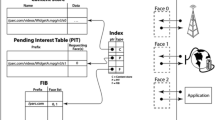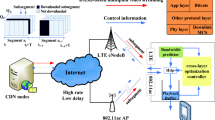Abstract
Bandwidth aggregation is a key research issue in integrating heterogeneous wireless networks, since it can substantially increase the throughput and reliability for enhancing streaming video quality. However, the burst loss in the unreliable wireless channels is a severely challenging problem which significantly degrades the effectiveness of bandwidth aggregation. Previous studies mainly address the critical problem by reactively increasing the forward error correction (FEC) redundancy. In this paper, we propose a loss tolerant bandwidth aggregation approach (LTBA), which proactively leverages the channel diversity in heterogeneous wireless networks to overcome the burst loss. First, we allocate the FEC packets according to the ‘loss-free’ bandwidth of each wireless network to the multihomed client. Second, we deliberately insert intervals between the FEC packets’ departures while still respecting the delay constraint. The proposed LTBA is able to reduce the consecutive packet loss under burst loss assumption. We carry out analysis to prove that the proposed LTBA outperforms the existing ‘back-to-back’ transmission schemes based on Gilbert loss model and continuous time Markov chain. We conduct the performance evaluation in Exata and emulation results show that LTBA outperforms the existing approaches in improving the video quality in terms of PSNR (Peak Signal-to-Noise Ratio).











Similar content being viewed by others
Notes
We choose the JSVM in convenience for the source code integration as both Exata and JSVM are developed using C++. However, the H.264/AVC JM [25] software is developed using C language.
References
Oliveira, T., Mahadevan, S., & Agrawal, D. P. (2011). Handling network uncertainty in heterogeneous wireless networks. In Proceedings of IEEE INFOCOM.
YouTube, http://www.youtube.com/.
Hulu, http://www.hulu.com/.
Cisco company (2013). Cisco visual networking index: Global mobile data traffic forecast update, 2012–2017. May 2013 (online). Available: http://www.cisco.com/en/US/solutions/collateral/ns341/ns525/ns537/ns705/ns827/white_paper_c11-520862.html.
Jurca, D., & Frossard, P. (2009). Media flow rate allocation in multipath networks. IEEE Transactions on Multimedia, 9(7), 1227–1240.
Han, S., Joo, H., Lee, D., & Song, H. (2011). An end-to-end virtual path construction system for stable live video streaming over heterogeneous wireless networks. IEEE Journal on Selected Areas Communications, 29(5), 1032–1041.
Mushroom Networks Inc. (2013). Wireless broadband bonding network appliance (online). Available: http://www.mushroomnetworks.com.
Ernst, T., Montavont, N., Wakikawa, R., & Kuladinithi, K., (2008). Motivations and scenarios for using multiple interfaces and global addresses. Internet-Draft, IETF MONAMI6 Working Group.
Chebrolu, K., & Rao, R. (2006). Bandwidth aggregation for real-time applications in heterogeneous wireless networks. IEEE Transactions on Mobile Computing, 5(4), 388–403.
Jurca, D., & Frossard, P. (2007). Video packet selection and scheduling in multipath networks. IEEE Transactions on Multimedia, 9(3), 629–641.
Chow, A., Yang, H., Xia, C., Kim, M., Liu, Z., & Lei, H. (2010). EMS: Encoded multipath streaming for real-time live streaming applications. In Proceedings of IEEE ICNP.
Sharma, V., Kalyanaraman, S., Kar, K., Ramakrishnan, K., & Subramanian, V. (2009). MPLOT: A transport protocol exploiting multipath diversity. In Proceedings of IEEE INFOCOM.
Ramaboli, A., Falowo, O., & Chan, A. (2012). Bandwidth aggregation in heterogeneous wireless networks: A survey of current approaches and issues. Journal of Networks and Computer Applications, 35(6), 1674–1690.
Zhu, X., & Boronat, F. (2009). Distributed rate allocation policies for multihomed video streaming over heterogeneous access networks. IEEE Transactions on Multimedia, 56(12), 2912–2933.
Song, W., & Zhuang, W. (2012). Performance analysis of probabilistic multipath transmission of video streaming traffic over multi-radio wireless devices. IEEE Transactions on Wireless Communications, 11(4), 1554–1564.
Jurca, D., Frossard, P., & Jovanovic, A. (2009). Forward error correction for multipath media streaming. IEEE Transactions on Circuits and Systems for Video Technology, 19(9), 1315–1326.
Yousaf, M., Qayyum, A., & Malik, S. A. (2012). An architecture for exploiting multihoming in mobile devices for vertical handovers & bandwidth aggregation. Wireless Personal Communications, 66(1), 57–79.
Quantities and units—part 13: Information science and technology. ISO/TC12 WG12, IEC/TC25, Geneva, Switzerland, ISO/IEC 80000–13: 2008, 2008 (online). Available: http://www.iso.org/iso/catalogue_detail?csnumber=31898.
Jain, M., & Dovrolis, C. (2002). Pathload: A measurement tool for end-to-end available bandwidth. In Proceedings of passive and active measurement workshop.
Ribeiro, V., Riedi, R., Baraniuk, R., Navratil, J., & Cottrell, L. (2003). pathChirp: Efficient available bandwidth estimation for network paths. In Proceedings of passive and active measurement workshop.
Konrad, A., Zhao, B., Joseph, A., & Ludwig, R. (2003). A Markov-based channel model algorithm for wireless networks. Wireless Networks, 9(3), 189–199.
Stuhlmüller, K., Färber, N., Link, M., & Girod, B. (2000). Analysis of video transmission over lossy channels. IEEE Journal on Selected Areas in Communications, 18(6), 1012–1032.
Exata (2013). http://www.scalable-networks.com/exata.
QualNet (2013). http://www.scalable-networks.com/qualnet.
H.264/AVC Reference Software, JM 18.2 (2012). (online). Available: http://iphome.hhi.de/suehring/tml/.
H.264/SVC reference software, JSVM 9.1.3 (2012). (online). Available: http://ip.hhi.de/imagecom-G1/savce/downloads/SVC-Reference-Software.htm.
Video Test Media (2013). (Online). Available: http://media.xiph.org/video/derf/.
Tu, W., & Jia, W. (2005). APB: An adaptive playback buffer scheme for wireless streaming media. IEICE Transactions on Communications, E88.B(10), 4030–4039.
ANSI T1.TR.74-2001 (2001). Objective video quality measurement using a peak-signal-to-noise-ratio (PSNR) full reference technique. Draft technical report, American National Standards Institute, Ad Hoc Group on Video Quality Metrics, Washington, DC, USA, Tech. Rep. T1.TR.74-2001, 2001 (online). Available: http://webstore.ansi.org/RecordDetail.aspx?sku=T1.TR.74-2001.
Acknowledgments
This research is supported by the National Grand Fundamental Research 973 Program of China under Grant Nos. 2011CB302506, 2013CB329102, 2012CB315802; National Key Technology Research and Development Program of China “Research on the mobile community cultural service aggregation supporting technology” (Grant No. 2012BAH94F02); Novel Mobile Service Control Network Architecture and Key Technologies (2010ZX03004-001-01); National High-tech R&D Program of China (863 Program) under Grant No. 2013AA102301; National Natural Science Foundation of China under Grant Nos. 61003067, 61171102, 61001118, 61132001; Program for New Century Excellent Talents in University (Grant No. NCET-11-0592); Project of New Generation Broadband Wireless Network under Grant No. 2011ZX03002-002-01; Beijing Nova Program under Grant No. 2008B50. The authors would like to express their sincere gratitude for the anonymous reviewers who provide the suggestions to improve the paper quality.
Author information
Authors and Affiliations
Corresponding author
Rights and permissions
About this article
Cite this article
Wu, J., Shang, Y., Cheng, B. et al. Loss Tolerant Bandwidth Aggregation for Multihomed Video Streaming over Heterogeneous Wireless Networks. Wireless Pers Commun 75, 1265–1282 (2014). https://doi.org/10.1007/s11277-013-1422-3
Published:
Issue Date:
DOI: https://doi.org/10.1007/s11277-013-1422-3




